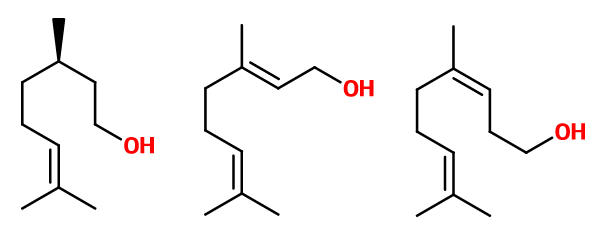

Zoomer à l'intérieur de la classification pour découvrir ses mille facettes !
Cliquer sur le nom d'un ingrédient ou d'un descripteur pour en savoir plus sur celui-ci !



| Liste des ingrédients contenants | ||
|---|---|---|
| Ingredient Name | CAS N° | Estimated Concentration |
| Geraniol | 106-24-1 | 0,3 |
| 1-Octen-3-yl acetate | 2442-10-6 | 0,06 |
| l-Carvone | 6485-40-1 | 67 |
| Carvone | 99-49-0 | 0,1 |
| l-Carvone | 6485-40-1 | 0,25 |
| Benzyl benzoate | 120-51-4 | 0,45 |
| Geraniol | 106-24-1 | 1,5 |
| Geraniol | 106-24-1 | 0,4 |
| Cat.1 | Cat.2 | Cat.3 | Cat.4 | Cat.5 | Cat.6 | Cat.7 | Cat.8 | Cat.9 | Cat.10 | Cat.11 |
|---|---|---|---|---|---|---|---|---|---|---|
| 0,8 % | 1,1 % | 4,4 % | 13,3 % | 7 % | 21,4 % | 2,2 % | 2 % | 5 % | 2,5 % | Non restreint |
| En contact avec la peau | Sans contact avec la peau | |
|---|---|---|
| Produits non rincés | Produits rincés | |
| Liste des ingrédients naturels contenants la matière présentée ici | |||
|---|---|---|---|
| Nom de l'ingrédient | Nom Botanique | CAS N° | Concentration estimée |
| Liste des ingrédients contenants | ||
|---|---|---|
| Ingredient Name | CAS N° | Estimated Concentration |
| Geraniol | 106-24-1 | 0,3 |
| d,l-Carvone | 99-49-0 | 0,4 |
| Safrole | 94-59-7 | 80 |
| beta-Thujone | 471-15-8 | 8 |
| alpha-Thujone | 546-80-5 | 25 |
| Thujone | 76231-76-0; 1125-12-8 | 33 |
| 1-Octen-3-yl acetate | 2442-10-6 | 0,06 |
| l-Carvone | 6485-40-1 | 67 |
| d,l-Carvone | 99-49-0 | 0,1 |
| l-Carvone | 6485-40-1 | 0,25 |
| Geraniol | 106-24-1 | 0,8 |
| Benzyl benzoate | 120-51-4 | 1,2 |
| Geraniol | 106-24-1 | 0,4 |
| Cat.1 | Cat.2 | Cat.3 | Cat.4 | Cat.5A | Cat.5B | Cat.5C | Cat.5D | Cat.6 |
|---|---|---|---|---|---|---|---|---|
| 2,2 % | 0,67 % | 13 % | 12 % | 3,2 % | 3,2 % | 3,2 % | 3,2 % | 7,3 % |
| Cat.7A | Cat.7B | Cat.8 | Cat.9 | Cat.10A | Cat.10B | Cat.11A | Cat.11B | Cat.12 |
| 25 % | 25 % | 1,3 % | 24 % | 87 % | 87 % | 48 % | 48 % | Non restreint |
| Liste des ingrédients naturels contenants la matière présentée ici | |||
|---|---|---|---|
| Nom de l'ingrédient | Nom Botanique | CAS N° | Concentration estimée |
| Cassia oil | Cinnamomum aromaticum Nees | 8007-80-5 | 3 |
| Cinnamon bark extract | Cinnamomum zeylanicum Blume | 8015-91-6 | 2,5 |
| Cinnamon bark oil | Cinnamomum zeylanicum Blume | 8015-91-6 | 5 |
| Cinnamon leaf oil | Cinnamomum zeylanicum Blume | 8015-91-6 | 1,7 |
| Hyacinth absolute | Hyacinthus orientalis L. | 8023-94-7 | 0,7 |
| Laurel leaf oil | Laurus nobilis L | 8007-48-5 | 0,1 |
| Ylang ylang oil I | Cananga odorata (Lam.) Hook. f. &Thomson oil (forma genuine Steenis) | 8006-81-3 | 4,2 |
| Ylang ylang oil II | Cananga odorata (Lam.) Hook. f. &Thomson oil (forma genuine Steenis) | 8006-81-3 | 2 |
| Ylang ylang oil III | Cananga odorata (Lam.) Hook. f. &Thomson oil (forma genuine Steenis) | 8006-81-3 | 1,5 |
| Ylang, Ylang oil extra | Cananga odorata (Lam.) Hook. f. &Thomson oil (forma genuine Steenis) | 8006-81-3 | 3 |
| Ylang, Ylang oil, terpene-free | Cananga odorata (Lam.) Hook. f. &Thomson oil (forma genuine Steenis) | 68952-44-3 | 4 |
Commentaires :
Linalool and natural products known to be rich in linalool, such as bois de rose, coriander or ho wood oil, should only be used when the level of peroxides is kept to the lowest practical level. It is recommended to add antioxidants at the time of production of the raw material. The addition of 0.1% BHT or alpha-tocopherol for example has shown great efficiency. The maximum peroxide level for products in use should be 20 millimoles per liter. The (hydro)peroxide content can be determined by using the FMA method.